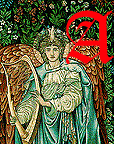 rchitect, designer, and an eccentric, William Burges was a prominent Gothic-revivalist whose designs in architecture, furniture, stained glass, and sculpture fused his vision of the Middle Ages, the observations from his extensive travels, and his own personality, creating in his work a new, eclectic style. As a master of detail and fantasy, Burges's attention reached from the walls and the stained glass windows of a building to each chair, dressing table, and vase in the rooms, giving his work aesthetic harmony.
rchitect, designer, and an eccentric, William Burges was a prominent Gothic-revivalist whose designs in architecture, furniture, stained glass, and sculpture fused his vision of the Middle Ages, the observations from his extensive travels, and his own personality, creating in his work a new, eclectic style. As a master of detail and fantasy, Burges's attention reached from the walls and the stained glass windows of a building to each chair, dressing table, and vase in the rooms, giving his work aesthetic harmony.
Burges's training came from not only his upbringing and schooling -- his father was a civil engineer and Burges studied the science of construction at King's College -- but also from his travels. Burges went to France and Belgium, Germany, Austria and Switzerland, Spain and Portugal, Italy, Sicily and Greece, Turkey, Egypt, Scandinavia and Japan, sketching and absorbing the architectural marvels, wall painting, and manuscripts in each country, particularly French Gothic, whose heavy forms and thick columns Burge admired for their "boldness, breadth, strength, sternness and virility," and the Japanese Court, whose egg-shell china, lacquer cabinets, suits of armor, textiles, and ivory ornaments, just to begin, retained the medieval techniques that had deserted Europe.
Burges believed that Pre-Raphaelitism and Gothicism went hand in hand. Color, faithfulness to his eye, and attention to detail were the founding principles of his designs, and he was a devoted follower of Pugin. Burges sought to control every aspect of his architectural commissions, designing elaborate decorative schemes in wood, stone, metal, paint, and marble to adorn the interiors and exteriors of his buildings. Stonework, woodwork, metal-work, glasswork -- all had to harmonize and conform to his own vision.
One of his major works is the St. Finbar's Cathedral in Cork, begun in 1862. He not only conceived and designed the building as a whole, but supervised every detail. His design recalls a thirteenth-century French cathedral, with aisles, towers, spires, and sculpture. For Burges, the sculpture, decoration, and furniture had to have a balanced relationship with the architecture. In St. Finbar's the colorful, lively decoration remains in equilibrium with the mass and scale of the architecture. Burges specifically designed his sculpture and furniture to fit in with the architectural structures and the richly painted interiors. He personally designed each of the 1,260 pieces of sculpture built into the Cork Cathedral. One example is Burges's carving of the four Evangelistic Beasts around the rose window, executed in such a way that the rim of the window confines the beasts without subduing their forcefulness, creating a balance between the geometry and weight of the window and the rocky, thrusting beasts.
His furniture was painted, and the decoration, in form and content, related directly to the painted interiors that housed them and to the function of the piece. He used bright colors and mini Pre-Raphaelite panels to adorn his boxy furniture designs. Burges painted his Bookcase (1859-62), holding art books, with paneled scenes emblematic of Christian and Pagan art. His painted decoration, stained glass, and mosaic, as well as his metalwork and jewelry, are a blend of thirteenth-century Gothic, Renaissance, Japanese, Assyrian, Islamic, and Byzantine styles, among others, and his own personal imagination. His vision for his house, designed himself, provides a ready example of his style. The house of Burges's dreams
was to be of perfect Medieval pattern, full of quaint carvings, and blazing color, hung with costly stuffs embroidered in gold, and lighted by silver lattices whose stories panes were of cut gems. He was to have jeweled chalices to drink from, and aloe and sandal wood to burn. [Crook 43]
In every aspect of design, Burges created a colorful, forceful vision, looking back to the Middle Ages but also, in combining elements of other periods and styles, creating a new Victorian style that was eclectic, glittering, and fantastic.
Questions
1. How does Burges use a Pre-Raphaelite aesthetic in his works?
2. Does Burges's work depart from Pugin's? How is Burges's personality conveyed through his works?
3. In what ways does Burges's sense of balance, harmony and decoration manifest in his other pieces, like his Dressing Table and Cup and Cover?
4. Burges said that the future of architecture must lie in a renaissance of the minor arts (Crook 11). How does Burges and other art-architects of the time translate techniques and principles of the minor arts into larger schemes for architecture?
References
Crook, J. Mordaunt. William Burges and the High Victorian Dream. Chicago: University of Chicago Press, 1981.
Crook, J. Mordaunt.The Strange Genius of William Burges. Cardiff: National Museum of Wales, 1981.
Last modified 20 November 2006